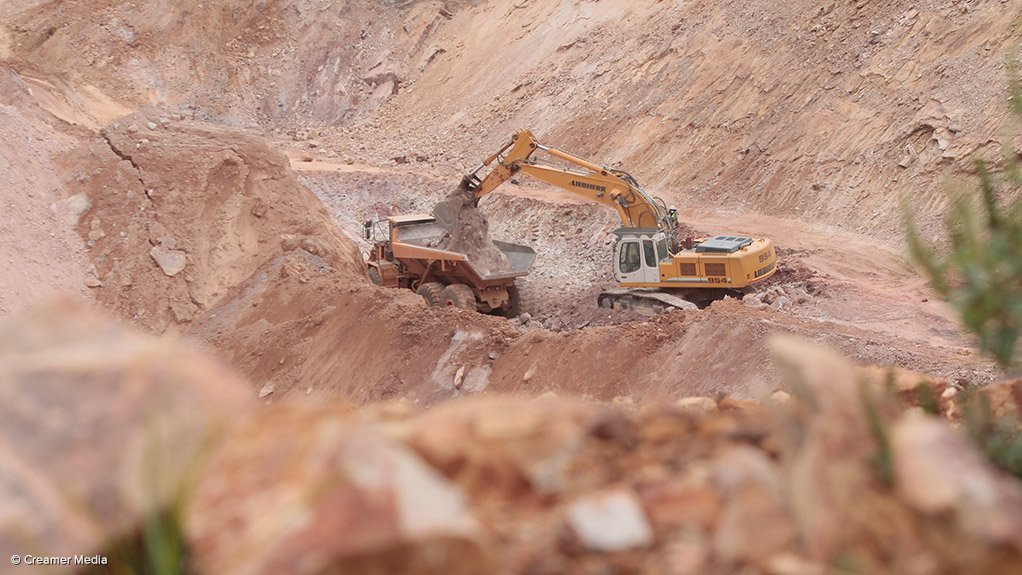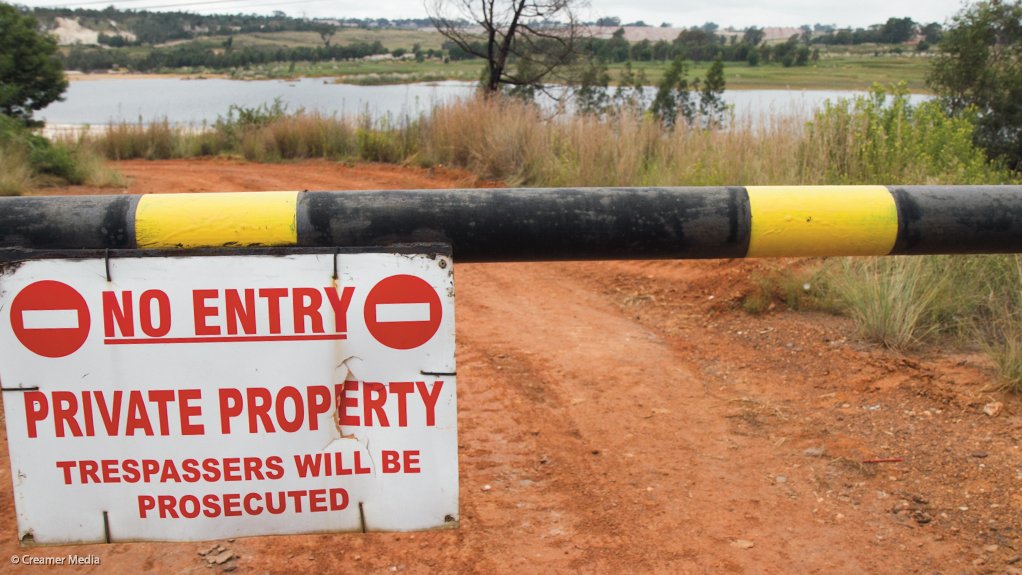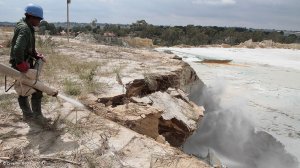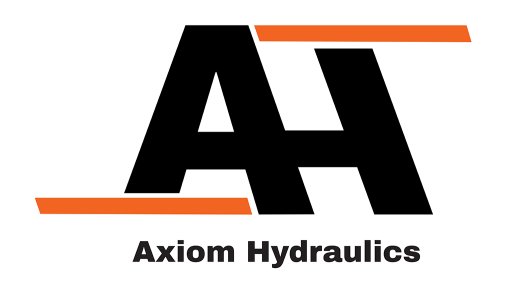Century of opencast mining leaves poor legacy




OUT WITH THE OLD Mintails is restoring old mining land and ecosystems to a condition that is consistent with best available practice, scientific knowledge and financial viability
GRINDING INVESTMENTMintails expects to spend around R85-million on mine closure costs by the time it ceases its planned 20 years of operation
CALLING A HALT Mintails is closing and securing unrehabilitated mine shafts and open holes on the surface to reduce illegal mining and its associated dangers
A historic legacy of opencast gold mining on Gauteng’s West Rand has impacted negatively on the area’s landscape and environment, says South Africa-focused mine tailings extractor Mintails, which has been facilitating mine closures at its goldfields on the West Rand since June 2013.
The West Rand mining region comprises mine dumps and high tailings walls, which are causing significant environmental issues for the surrounding community. Mintails is filling unoperational opencast mines in an attempt to rehabilitate the area.
“A ‘virtuous cycle’ approach has been designed to provide multiple benefits across the value spectrum – social, environmental and/or economic,” says Mintails operations GM Jan Jacobs, who identifies the issues being faced as legacy issues.
Some of these legacy issues include uranium-rich mine dumps – which not only damage the landscape but also pose a threat to the environment when exposed to wind and rainwater – and mine voids, which can cause the decant of acid mine drainage (AMD).
Jacobs explains that vast and abandonded areas also pose a significant environmental challenge. “The 100 km stretch of land from Randfontein, in the west, to Springs, in the east, is characterised by geotechnical instability, as it was never remediated, with illegal mining subsequently taking place along surface reefs.”
Meanwhile, the health of communities living near mine dumps is also being threatened as the demand for housing and the subsequent development of rural townships continues to grow.
“There are more than one-million tons of tailings on the surface in the Randfontein cluster area, which were deposited during mining operations over the last 100 years. The total footprint of the tailings amounts to more than 600 ha of ‘dead’ land,” says Jacobs.
He explains that Mintails’ approach to treating mine dumps involves the economic activity of ore processing, removing the source of pollution, implementing dust control, removing the pyrite-based material from which AMD is generated and breaking the chemical chain reaction that generates AMD.
These dumps are seeping contaminants into the groundwater and are also affecting the quality of surface-water resources. Further, communities living close to the dumps can experience dust pollution and health problems caused by high dust fallout levels.
Moreover, Jacobs adds that subsistence miners dig dangerous tunnels that can cause them injury or even death. “The gold extraction methods used by subsistence miners lead to mercury contamination, resulting in environmental hazards to the surrounding area.”
Implementing Solutions
Mintails is developing a single solution on the West Rand for multiple tailings facilities through the mining of historical tailings and depositioning these into a single deposition facility identified for permanent closure to leave a positive and lasting legacy on the West Rand.
“Mining the tailings provides an opportunity to rehabilitate and remedy the environmental impact of unrehabilitated decommissioned mines,” says Jacobs.
The removal of these dumps will decrease dust, surface and groundwater pollution, and the associated rehabilitation of the mines’ environ- mental footprints will assist in remedying the radiation pollution on the West Rand.
The rehabilitation of the associated footprints will release land that can be used for development. “Gauteng is growing rapidly and land is needed for development,” says Jacobs.
Mintails is extracting all potential pollution-generating sources of pyrite-based material, including remaining underground resources and surface tailings dumps, on the West Rand.
Rehabilitation is planned for implementation within one year of any footprint clearing and Mintails expects to spend about R85-million on closure costs by the time it ceases its planned 20 years of operation.
Technology
Mintails has developed and patented a technology capable of treating AMD to safe levels for industrial-process purposes.
The company highlights the many benefits of the technology, including the low-cost treatment of water, job creation while cleaning up the landscape and the elimination of costly storage facilities for the highly concentrated waste generated by other neutralisation processes.
“This technology has been presented to the South African government as part of the solution to the mining legacy problem,” says Jacobs.
He further highlights that the reclamation of dumps will result in the cessation of subsistence mining. “Mintails is closing and securing unrehabilitated mine shafts and open holes on the surface to reduce illegal mining and its associated dangers.”
Environmental Assessment
To ensure the environmental rehabilitation of the Witwatersrand basin, Mintails has halted the overflow of highly contaminated water from Lancaster dam into the Wonderfontein Spruit. “We raised the wall to create a containment facility and we are systematically removing the dumps that encircle the upper catchment,” says Jacobs.
Meanwhile, the previously uncontrolled decant of AMD into the Tweelopies Spruit has been stopped, with the last outflow recorded on October 9, 2012.
In the West Wits pit, Mintails is lowering the water table to prevent leaching of corrosive water into the environment. “A comprehensive plan is being developed for the safe closure of the West Wits pit, supported by the best available science. This will prevent the continued ingress of water into the mine void and will also make that highly impacted landscape safe once again,” says Jacobs.
Mintails is removing the on-surface reef outcrops through opencast mining, and is also stabilising the land, enabling the surrounding communities to safely use these areas.
The company is restoring land and ecosystems to a condition that is consistent with best available practice, scientific knowledge and financial viability. “Engagement with public stakeholders plays a pivotal role in Mintails’ strategy for environmental sustainability,” concludes Jacobs.
Article Enquiry
Email Article
Save Article
Feedback
To advertise email advertising@creamermedia.co.za or click here
Comments
Press Office
Announcements
What's On
Subscribe to improve your user experience...
Option 1 (equivalent of R125 a month):
Receive a weekly copy of Creamer Media's Engineering News & Mining Weekly magazine
(print copy for those in South Africa and e-magazine for those outside of South Africa)
Receive daily email newsletters
Access to full search results
Access archive of magazine back copies
Access to Projects in Progress
Access to ONE Research Report of your choice in PDF format
Option 2 (equivalent of R375 a month):
All benefits from Option 1
PLUS
Access to Creamer Media's Research Channel Africa for ALL Research Reports, in PDF format, on various industrial and mining sectors
including Electricity; Water; Energy Transition; Hydrogen; Roads, Rail and Ports; Coal; Gold; Platinum; Battery Metals; etc.
Already a subscriber?
Forgotten your password?
Receive weekly copy of Creamer Media's Engineering News & Mining Weekly magazine (print copy for those in South Africa and e-magazine for those outside of South Africa)
➕
Recieve daily email newsletters
➕
Access to full search results
➕
Access archive of magazine back copies
➕
Access to Projects in Progress
➕
Access to ONE Research Report of your choice in PDF format
RESEARCH CHANNEL AFRICA
R4500 (equivalent of R375 a month)
SUBSCRIBEAll benefits from Option 1
➕
Access to Creamer Media's Research Channel Africa for ALL Research Reports on various industrial and mining sectors, in PDF format, including on:
Electricity
➕
Water
➕
Energy Transition
➕
Hydrogen
➕
Roads, Rail and Ports
➕
Coal
➕
Gold
➕
Platinum
➕
Battery Metals
➕
etc.
Receive all benefits from Option 1 or Option 2 delivered to numerous people at your company
➕
Multiple User names and Passwords for simultaneous log-ins
➕
Intranet integration access to all in your organisation

















